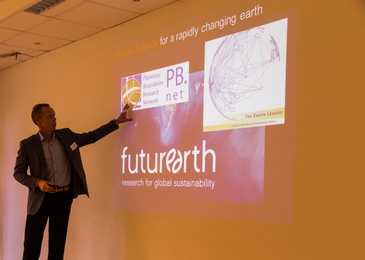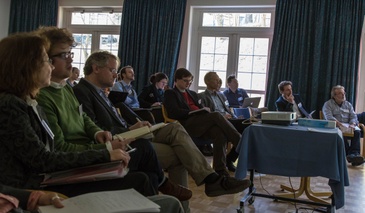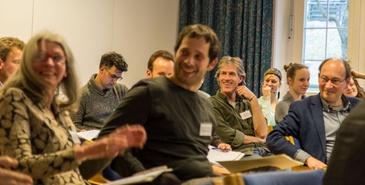
 The opening dinner on Sunday evening offered the participants first opportunities for discussions and for getting acquainted. On Monday, the first part of the day was dedicated to scene-setting presentations on where we currently stand and next steps in Earth system modelling by the invited speakers as well as focussed perspectives presentations by the workshop participants. The scene-setting talks covered topics ranging from Earth system perspectives on the Anthropocene (Timothy Lenton) over Blueprinting a Whole Earth Model (Wolfgang Lucht) to Building the moon lander: what is needed next in Earth modelling (Johan Rockström). Most of the other about 30 workshop participants presented their specific perspectives on social systems modelling, innovative methods, and environmental modelling (see workshop programme). The aim of these two modes of presentation was to collect the many perspectives and ideas from all LOOPS participants to receive a lot of input before deliberating on joint modelling, new ideas and joint papers.
The opening dinner on Sunday evening offered the participants first opportunities for discussions and for getting acquainted. On Monday, the first part of the day was dedicated to scene-setting presentations on where we currently stand and next steps in Earth system modelling by the invited speakers as well as focussed perspectives presentations by the workshop participants. The scene-setting talks covered topics ranging from Earth system perspectives on the Anthropocene (Timothy Lenton) over Blueprinting a Whole Earth Model (Wolfgang Lucht) to Building the moon lander: what is needed next in Earth modelling (Johan Rockström). Most of the other about 30 workshop participants presented their specific perspectives on social systems modelling, innovative methods, and environmental modelling (see workshop programme). The aim of these two modes of presentation was to collect the many perspectives and ideas from all LOOPS participants to receive a lot of input before deliberating on joint modelling, new ideas and joint papers.
 Consequently, the second part of the day was dedicated to two rounds of hands-on work in small break-out groups for establishing connections, planning joint modelling projects and papers. After self-organizing into several working groups, the participants spread out over the hotel and focussed on designing in parallel joint papers on topics ranging from The Planetary Boundary concept under scrutiny: observational constraints of and opportunities for model evaluation (M. Mahecha et al.), over A taxonomy of links and loops: Towards definition, quantification and classification of co-evolutionary feedbacks in the global society-environment system (J.F. Donges et al.), Seven challenges for predictive models of human interaction with the Earth system (H. Williams et al.), Ways to represent opinion formation and decision making in Earth System Models (R. Hegselmann et al.) to Revolutions in energy and material cycling in human and Earth history (T. Lenton et al.). After an inspiring pre-dinner speech by John Schellnhuber, the LOOPS participants settled for dinner and evening conversations in the cosy restaurant Immenstube.
Consequently, the second part of the day was dedicated to two rounds of hands-on work in small break-out groups for establishing connections, planning joint modelling projects and papers. After self-organizing into several working groups, the participants spread out over the hotel and focussed on designing in parallel joint papers on topics ranging from The Planetary Boundary concept under scrutiny: observational constraints of and opportunities for model evaluation (M. Mahecha et al.), over A taxonomy of links and loops: Towards definition, quantification and classification of co-evolutionary feedbacks in the global society-environment system (J.F. Donges et al.), Seven challenges for predictive models of human interaction with the Earth system (H. Williams et al.), Ways to represent opinion formation and decision making in Earth System Models (R. Hegselmann et al.) to Revolutions in energy and material cycling in human and Earth history (T. Lenton et al.). After an inspiring pre-dinner speech by John Schellnhuber, the LOOPS participants settled for dinner and evening conversations in the cosy restaurant Immenstube.
 Overnight, the working groups' rapporteurs forged the day's results into a first round of abstracts for the Special Issue in Earth System Dynamics and reported on these plans after breakfast on Tuesday morning. In the following, a third round of break-out group sessions allowed for continued discussions on abstracts, paper plans and modelling projects. After a wrap-up by Wolfgang Lucht on Special Issue planning, joint modelling, and next steps in the LOOPS process, the workshop ended sociably with a guided tour of the historic Chorin Monastery ruins.
Overnight, the working groups' rapporteurs forged the day's results into a first round of abstracts for the Special Issue in Earth System Dynamics and reported on these plans after breakfast on Tuesday morning. In the following, a third round of break-out group sessions allowed for continued discussions on abstracts, paper plans and modelling projects. After a wrap-up by Wolfgang Lucht on Special Issue planning, joint modelling, and next steps in the LOOPS process, the workshop ended sociably with a guided tour of the historic Chorin Monastery ruins.





